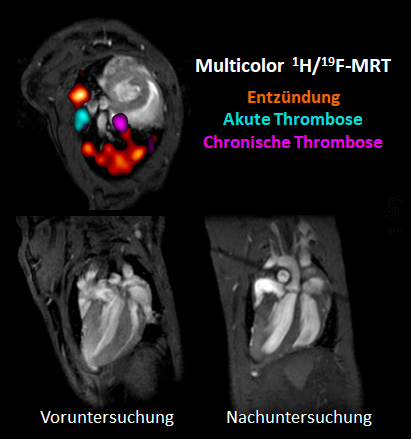The cascade of these vascular diseases ranges from inflammation of the vessel, thrombosis with subsequent detachment of minute particles of the vascular plaque, to vascular occlusion resulting in permanent damage due to e.g. myocardial infarction.
To show the hazard patterns, three molecules (ligands) - are coupled to different types of perfluorocarbon nanoemulsion. They are specifically directed respectively to sites of inflammation, acute and chronic thrombi. There, they embed themselves and become visible and distinguishable through the use of a specific MRI imaging technique (19F-MRI).
This enables the scientists to identify areas that are at high risk of developing a heart attack. This happens at a time when no conventional parameter in laboratory diagnostics or ECG indicates an imminent danger. The research team shows that these patterns can be visualized reliably - and before the onset of infarction - by the "multi-color multi-targeted' 1H/19F MRI" technique they developed. Only a single MRI scan is required, which can localize individually affected sites and differentiate them by color with respect to inflammation, freshly developed or advanced thrombi.
Thereby, the early identified vulnerable sites may well be different in the individual (mouse model). However, it is important that in each case the corresponding massive secondary damage also occurred at these sites. In further studies, Flögel et al. showed that the "multi-targeted 1H/19F MRI method" is able to clearly visualize the entire vicious circle of platelet adhesion, infiltration of immune cells and formation of thrombi leading to coronary atherothrombosis, myocardial infarction and severe deterioration of ventricular function.
Original publication:
Ulrich Flögel, Sebastian Temme, Christoph Jacoby, Thomas Oerther, Petra Keul, Vera Flocke, Xiaowei Wang, Florian Bönner, Fabian Nienhaus, Karlheinz Peter, Jürgen Schrader, Maria Grandoch, Malte Kelm & Bodo Levkau; Multi-targeted 1H/19F MRI unmasks specific danger patterns for emerging cardiovascular disorders, NATURE COMMUNICATIONS| (2021) 12:5847
https://doi.org/10.1038/s41467-021-26146-6


